Dr.Teruo Higa’s
Living A Dream
- 2025
- Sep:#209 The Widespread Use of EM in Ecuador
- Sep:#208 The Widespread Use of EM in Chile
- Jul:#207 Peru, where EM has taken root throughout the country
- May:#206 EM Application Technology in Paraguay Begins to Evolve into Advanced Circular Agriculture
- May:#205 Practical Application of Soil Disinfectant-Free Cultivation Using EM Technology
- Apr:#204 How EM Use Has Spread Throughout the Philippines
- Mar:#203 How to Use EM to Fundamentally Solve the Problem of Agricultural Residue Burning
- Feb:#202 The Spread of EM technology in Germany
- Jan:#201 The 2nd Ichiro Masaki Memorial Universal Village EM International Conference
- Jan:#200 Cleanup of the Ala Wai Canal in Hawaii, where social bonds are strengthened using EM
- 2024
- Nov:#199 EM trials in India with bananas, tomatoes, and pomegranates
- Oct:#198 The Steadily Evolving EM Nature Farming Method at the Blue Sky Palace - Part 8
- Sep:#197 The Steadily Evolving EM Nature Farming Method at the Blue Sky Palace - Part 7
- Aug:#196 The Steadily Evolving EM Nature Farming Method at the Blue Sky Palace - Part 6
- Jul:#195 The Steadily Evolving EM Nature Farming Method at the Blue Sky Palace - Part 5
- Jun:#194 Steadily Evolving EM Nature Farming Method at the Blue Sky Palace - Part 4
- May:#193 Steadily Evolving EM Nature Farming Method at the Blue Sky Palace - Part 3
- May:#192 Steadily Evolving EM Nature Farming Method at the Blue Sky Palace - Part 2
- Apr:#191 Steadily Evolving EM Nature Farming Method at the Blue Sky Palace
- Mar:#190 Quantum Mechanical Effects of EM Gravitron Charcoal
- Mar:#189 The barrier space in Okinawa (Ryukyu Islands) has risen to another dimension
- Jan:#188 Sixty Days after Typhoon No.6
- 2023
- Oct:#187 Supermassive Typhoon No.6 and Subsequent Typhoon No. 11
- Sep:#186 Massive Typhoon No.6 that swallowed the Ryukyu Islands Graviton barrier
- Sep:#185 August 8th is World “EM Mudball Day”
- Aug:#184 A disease-free life depends on the health of the intestinal microbiome.
- Jul:#183 Trial and Error at the Blue-Sky Palace, Part 3
- Jun:#182 Trial and Error at the Blue-Sky Palace, Part 2
- Apr:#181 Trial and Error at the Blue-Sky Palace
- Mar:#180 Ala Wai Canal Cleanup Project in Waikiki, Hawaii
- Feb:#179 High-Yield, High-Quality Rice Production Using EM
- Feb:#178 The Progress the "Soil Preparation Workshop" of the Oishi 3-chan Club (Part 2)
- Jan:#177 Organic Farming Instructional Manual Using EM
- 2022
- Nov:#176 The Typhoon Situation in Okinawa in 2022
- Sep:#175 Third-Party Verification of the Graviton barrier in Okinawa Part-2
- Sep:#174 Third-Party Verification of the Graviton barrier in Okinawa
- Aug:#173 Ecosystem Changes Observed in Okinawa in 2021 Part-5
- Jun:#172 Ecosystem Changes Observed in Okinawa in 2021 Part-4
- May:#171 Ecosystem Changes Observed in Okinawa in 2021 Part-3
- Apr:#170 Ecosystem Changes Observed in Okinawa in 2021 Part-2
- Mar:#169 Koizumi Farm in Kamakura Continues to Evolve
- Feb:#168 Ecosystem Changes Observed in Okinawa in 2021 Part-1
- 2021
- Dec:#167 Enjoying EM Technology While Enriching the Local Ecosystem
- Nov:#166 A Case Study of the Use of EM in a Next Generation Free School in Tune with the Cycles of Nature
- Oct:#165 Typhoon conditions and flowers in Okinawa from August to October
- Sep:#164 Re-learning the origins of river purification using EM Cleaning up the Dairyuji River in Senami (Murakami City, Niigata Prefecture)
- Aug:#163 Measures Against Natural Disasters and Re-learning the Starting Point of EM
- Jul:#162 Summary of FFC (Foods for Children) Okinawa Forum 2021
- Jun:#161 Restoring the Vigor of an Old Tree and Purifying the Environment with EM Technology That Even an Amateur Can Do
- May:#160 The Public is Beginning to Recognize the Use of EM Smokeless Carbonizers
- Apr:#159 EM Hado (EM Graviton) that exerts quantum superposition effect over time
- Mar:#158 Virus-free Okinawan Plants Through Use of an EM Graviton Barrier
- Jan:#157 Enjoyable Farming for Self-Sufficiency that Even Amateurs Can Do
- 2020
- Dec:#156 EM quantum energy effect occurring in Okinawa
- Nov:#155 Implementing EM graviton farming as a flood countermeasure for apple orchards
- Oct:#154 The Latest Book on the Practical Uses of EM "You Are the One Who Draws Out the Power of Microorganisms," by Chizuko Nomoto
- Sep:#153 Application of EM technology to long periods of rain, lack of sunshine, storms, heavy rains, etc.
- Aug:#152 EM application in Kitanakagusuku village plant waste recycling yard
- Jul:#151 Natural Disaster Countermeasures Using EM Technology: Part 2
- Jul:#150 Natural Disaster Countermeasures Using EM Technology
- May:#149 How to make your home and workplace an energy spot by living a complete EM lifestyle: creating the ultimate source of health and environmental purification
- Apr:#148 EM, Viruses and the Pandemic
- Apr:#147 New agriculture applying quantum mechanics Part 2
- Apr:#146 New agriculture applying quantum mechanics
- Apr:#145 Wonderful EM Miracle
- 2019
- Nov:#144 The movie “Revival II” and the reality of Fukushima
- Oct:#143 Boundary dome and foliar spraying of EM・X GOLD and EM 3
- Oct:#142 Kirakira (Sparkling) Summer Vegetable Festa in 2019
- Aug:#141 Excessive salt inevitably causes salt damage
- Jul:#140 Diverse applications of charcoal Part 3
- Jun:#139 Diverse applications of charcoal Part 2
- Jun:#138 Diverse applications of charcoal
- Jun:#137 Purification power of salt
- May:#136 The degree of soil contamination is a reflection of the microflora
- May:#135 Definitive use of EM barriers to deal with typhoons
- May:#134 Implementing authentic Nature Farming
- May:#133 How to enhance healthy Hado (wave energy) by EM
- May:#132 Eating Dirt (Soil)
- May:#131 Hado (Wave energy) involved in health
- May:#130 Reaffirming EM technology to realize the essence of agriculture
- May:#129 The 2nd EM Producer Networking Meeting
- Apr:#128 Understanding the application of seawater and salt in crop cultivation
- Apr:#127 Prevention of Disasters by EM Technology
- Mar:#126 Quantum overlay effective utilization of EM
- Jan:#125 EM Disaster Recovery Support Projects in 2017
- 2018
- 2017
- Aug:#121 Escape from conventional agricultural traps
- Jul:#120 Limitation and important caveats regarding utilization of salt
- Jun:#119 EM Technology to Break Through the Limits of Pesticide-Free Strawberries
- May:#118 Application of barriers using EM rectification force
- Apr:#117 The 1st EM Produce Growers' Networking Conference
- Mar:#116 Sumizo kun: The Ultimate Versatile Carbonization Equipment
- Feb:#115 How to make and use simple carbonized and rectified ash
- Jan:#114 Achievements of 2016
- 2016
- Dec:#113 Definitive Measures Against Typhoons
- Nov:#112 International Conference on Universal Village
- Oct:#111 90% of Your Body is Microbes
- Sep:#110 Disaster Countermeasures Using EM
- Aug:#109: Changes in the Natural Environment by EM Barrier Domes in Okinawa
- Jul:#108: Multi-purpose Utilization of Activated EM with Seawater and Salt
- Jun:#107: Marine Day, when EM Mudballs and Activated EM are Applied Throughout Japan
- May:#106: The Function of EM and Gravitational Waves–Part 3
- Apr:#105: The Function of EM and Gravitational Waves–Part 2
- Feb:#104: The Function of EM and Gravitational Waves
- Feb:#103: The Importance of Phototrophic Bacteria in EM
- 2015
- Dec:#102: Results of Environmental Forum "Utsukushima EM Paradise" 2015
- Nov:#101: Environmental Forum "Utsukushima EM Paradise" 2015
- Oct:#100: A New Phase of Limit Breakthrough Using EM
- Sep:#99: A New Phase of Limit Breakthrough through EM
- Aug:#98: The Tokyo Bay Area Began Creating a Truly Livable Hometown
- Jul:#97: Rectifying Effects of EM
- Jun:#96: Lake Suwa Sousei lecture
- May:#95: In Order to Further Ensure Limit Breakthrough
- Apr:#94: Theatrical Release of the Documentary Film SOSEI-Revival to Enlighten People on the New Possibilities of Microorganisms
- Mar:#93: What Underlies Limit Breakthrough (Part 2)
- Feb:#92: EM Functions to Break Through Limits
- Jan:#91: At the Start of 2015
- 2014
- Dec:#90: Looking Back at 2014
- Nov:#89: Shikoku EM FESTA 2014, Virtuous Circle Conference in Matsuyama, Ehime Prefecture
- Oct:#88: Using EM to Deal with Weather Disasters (Part 2)
- Sep:#87: Current Status of Radioactivity Measures Using EM in Fukushima
- Aug:#86: APNAN (Asia Pacific Natural Agriculture Network) 25th Anniversary Conference in 2014
- Jul:#85: Using EM to Deal with Weather Disasters
- Jun:#84: Substantial Improvement of Soil
- May:#83: The Energy Rectification Force of EM
- Apr:#82: The Annual 18th EM Technology Exchange Meeting and Tohoku Conference in Shichigahama
- Mar:#81: Salmon going upstream in Kitaura (Kasumigaura)
- Feb:#80: The Microbiome Again
- Jan:#79: Inauguration of the Federation of Diet Members Who Use and Apply Effective Microorganisms
- 2013
- Dec:#78: Receiving an Honorary Doctoral Degree from Rajamangala University of Technology in Thailand
- Nov:#77: The Use of EM in School Education in Bhutan
- Oct:#76: Well of Bonding
- Sep:#75: The Background to EM Not Being Employed by Public Institutions to Deal with Radiation
- Aug:#74: Dealing with Disaster: Using EM in Crisis Management
- Jul:#73: EM Events on Ocean Day
- Jun:#72: Using EM to Deal With Heat Stroke and Summer Heat Fatigue
- May:#71: An EM Model Town in Malaysia
- Apr:#70: Steps the Japanese Government is Taking to Deal with Radiation: Are They Really Safe?
- Mar:#69: EM Group Disaster Reconstruction Aid Project in Fukushima
- Feb:#68: EM and Microbiomes (Microbial Flora)
- Jan:#67: A Necessary Evil is Still Evil
- 2012
- Dec:#66: The 17th National EM Technology Exchange Conference / Hokkaido Conference in Sapporo
- Nov:#65: EM Forum 2012 in Okinawa and the Environmental Forum in Fukushima
- Oct:#64: 2012 EM Forum
- Sep:#63: A New Earth Saving Revolution
- Aug:#62: The Asahi Newspaper’s Misguided Reports About EM
- Jul:#61: Using EM in Radioactive Contamination Measures in Fukushima Prefecture
- Jun:#60: The Effects of Using EM to Inhibit the Absorption of Radioactivity as Confirmed in Fukushima
- May:#59: Recovery Support for the Great East Japan Earthquake
- Apr:#58: The Royal Kingdom of Thailand, in which EM Functions as a Set Government Policy
- Mar:#57: Report on the Measures Taken by Kingdom of Thailand Using EM to Deal with Polluted Water
- Feb:#56 EM™ as Part of National Policy in Thailand to Deal with Sanitation Issues Resulting from the Flood of 2011
- Jan:#55 The Law of Syntropy (Revitalization)
- 2011
- Dec:#54 EM Forum 2011
- Nov:#53 Shikoku EM Festa 2011- Zenjunkan no Wa (Virtuous Circle) Tokushima Conference in Naruto -
- Oct:#52 The Mystery of Interim Safety Values for Radioactive Material
- Sep:#51 Successful Radiation Countermeasures Using EM
- Aug:#50 Events on Sea Day in which EM Mud Balls are Thrown into the Water and Activated EM is Applied.
- May:#47 Dealing with the Damage Caused by the Eastern Japan Earthquake
- Apr:#46 Eastern Japan Earthquake
- Mar:#45 The 16th National EM Technology Hokuriku Conference in Fukui
- Feb:#44 More Thoughts on Avian Influenza and Foot-and-Mouth Disease
- Jan:#43 Happy New Year!
- 2010
- Dec:#42 Shikoku EM FESTA 2010・Zenjunkan no wa (Virtuous Circle) Fellowship Conference in Tobe, Ehime Prefecture
- Nov:#41 EM Forum 2010
- Oct:#40: My Thanks to the EM™ Volunteers Who Helped in the Fight Against Foot-and-Mouth Disease in Miyazaki Prefecture
- Sep:#39 International EM Mud Ball Day
- Jul:#37 Poland EM Forum 2010
- Jun:#36 EM Countermeasures Against Foot-and-Mouth Disease
- May:#35 Abnormal Weather
- Apr:#34 EM Activities in Thailand: Finding Solutions to the Challenges Facing the Nation
- Mar:#33 New Developments in the Evolution of EMTM in Thailand
- Feb:#32 Results Starting to Be Seen at the Mikasa Project
- Jan:#31 Towards an EM-Use Society
- 2009
- Dec:#30 EM Summit
- Nov:#29 The System in Penang State in Malaysia that Made the World EMTM Mudball Day a Success
- Oct:#28 The "World EM Mudball Day" in Malaysia
- Sep:#27 Validating EMTM Medicine: Case Study Reports from EM Users 2009. (Part 3)
- Sep:#26 Validating EMTM Medicine: Case Study Reports from EMTM Users 2009. (Part 2)
- Jul:#25 Validating EMTM Medicine: Case Study Reports from EMTM Users 2009. (Part 1)
- Jun:#24 Activities to Disseminate EM-Focused Nature Farming in China
- May:#23 Use of EMTM in Response to Swine Flu
- Apr:#22 Using EM to Solve Public Administrative Costs
- Mar:#21 Reaffirming the Versatility of EM
- Jan:#20 The Beginning of a New Era
- 2008
#165 Typhoon conditions and flowers in Okinawa from August to October

The Gravitron Kekkai (barrier) of the Ryukyu Islands, which started in November, 2013, is structured so that the superposition effect is steadily manifested through the entire Okinawa power grid, evidence of which has been confirmed now through a variety of phenomenon.
In other words, while confirming that the mechanism that increases EM power in Okinawa’s space has strengthened year by year, we continue to experientially check and observe subsequent changes in nature and the environment.
Regarding typhoons so far, the Kekkai was created in November 2013, and since 2014 the number of typhoons has significantly decreased, and since 2015 the amount of major damage has decreased tremendously. I have explained this mysterious situation in this online magazine series a number of times. This trend is stabilizing year by year. People who experienced severe typhoon damage in the past are now aware that typhoons either do not hit Okinawa, or when they do, the damage is minimal, since there has been little noticeable damage for more than five years. In my 75 plus years of being aware of the natural environment, I have never experienced anything like this year.
Typhoons No. 9, 12, 14, 16 and 18, which were predicted to significantly effect Okinawa instead shifted their courses. Typhoons No. 12 and 14 were predicted to directly strike the Ishigaki Islands, but they drastically shifted to the west and moved northward around the periphery of the Kekkai.
This phenomenon has never happened before, so I will keep a record it in this issue of Ecopure and continue to keep a close eye on it every year.
The flowers introduced in the local newspaper have been increasing in power every year, the phenomenon of limit breakthrough that was impossible in the past. The colors of the flowers have become more vivid, and they open up wider. As typhoons have had less of an effect on the flowers this year, more species have been blooming out of season, making this the best year ever for flower lovers.
(All articles are provided by Okinawa Times)
In other words, while confirming that the mechanism that increases EM power in Okinawa’s space has strengthened year by year, we continue to experientially check and observe subsequent changes in nature and the environment.
Regarding typhoons so far, the Kekkai was created in November 2013, and since 2014 the number of typhoons has significantly decreased, and since 2015 the amount of major damage has decreased tremendously. I have explained this mysterious situation in this online magazine series a number of times. This trend is stabilizing year by year. People who experienced severe typhoon damage in the past are now aware that typhoons either do not hit Okinawa, or when they do, the damage is minimal, since there has been little noticeable damage for more than five years. In my 75 plus years of being aware of the natural environment, I have never experienced anything like this year.
Typhoons No. 9, 12, 14, 16 and 18, which were predicted to significantly effect Okinawa instead shifted their courses. Typhoons No. 12 and 14 were predicted to directly strike the Ishigaki Islands, but they drastically shifted to the west and moved northward around the periphery of the Kekkai.
This phenomenon has never happened before, so I will keep a record it in this issue of Ecopure and continue to keep a close eye on it every year.
The flowers introduced in the local newspaper have been increasing in power every year, the phenomenon of limit breakthrough that was impossible in the past. The colors of the flowers have become more vivid, and they open up wider. As typhoons have had less of an effect on the flowers this year, more species have been blooming out of season, making this the best year ever for flower lovers.
(All articles are provided by Okinawa Times)
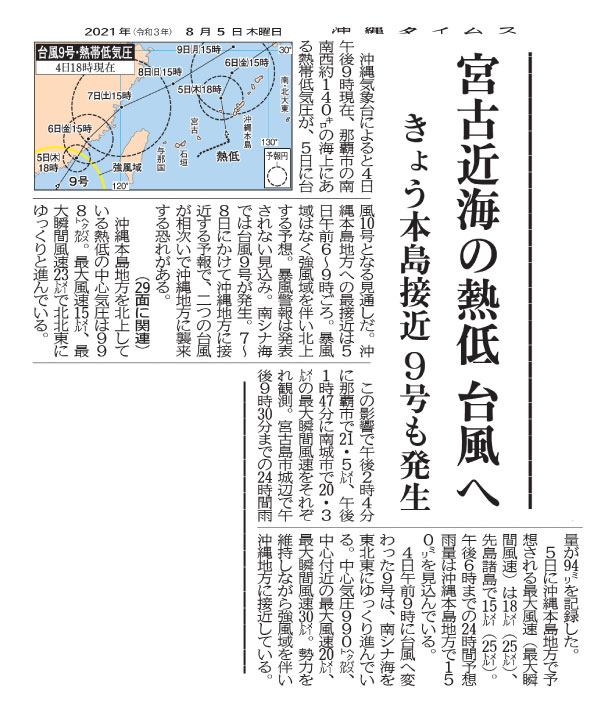
A tropical depression located near Miyako Island expected to become a typhoon, approaching the main island today.
Typhoon No. 9 also formed
August 5, 2021
According to the Okinawa Meteorological Observatory, as of 9 pm on the 4th, a tropical depression located about 140 km southwest of Naha City is expected to become Typhoon No.10 on August 5. The closest approach to the main island of Okinawa will be around 6 to 9 am on the 5th. It is expected to move northward with strong winds, without storm areas. No storm warning is expected to be issued. Typhoon No. 9 has also formed in the South China Sea. These two typhoons are predicted to approach the Okinawa region from the 7th to the 8th, and there is a possibility that they will strike the region in succession.
The tropical depression moving northward over the Okinawa main island has a central pressure of 998 hectopascals. It is slowly moving to the north-northeast with a maximum wind speed of 15 meters and a maximum instantaneous wind speed of 23 meters.
As a result, a maximum instantaneous wind speed of 21.5 meters was observed in Naha City at 2:04 pm and 20.3 meters in Nago City at 1:47 pm The amount of rainfall in twenty-four hours, in the period ending at 9:39 pm, was recorded at 94 millimeters in Gusukube, Miyakojima City.
The maximum wind speed (maximum instantaneous wind speed) expected in the Okinawa main island region on the 5th is 18 meters (25 meters), and 15 meters (25 meters) in the Sakishima Islands. The expected rainfall for the next 24 hours until 6:00 pm is 150 millimeters in the Okinawa main island area.
Typhoon No. 9, which turned into a typhoon at 9 am on the 4th, is slowly moving east-northeast through the South China Sea. It has a central pressure of 990 hectopascals, a maximum wind speed of 20 meters near the center, and maximum instantaneous wind speed of 30 meters. It is maintaining its intensity as it approaches the Okinawa area with strong winds.
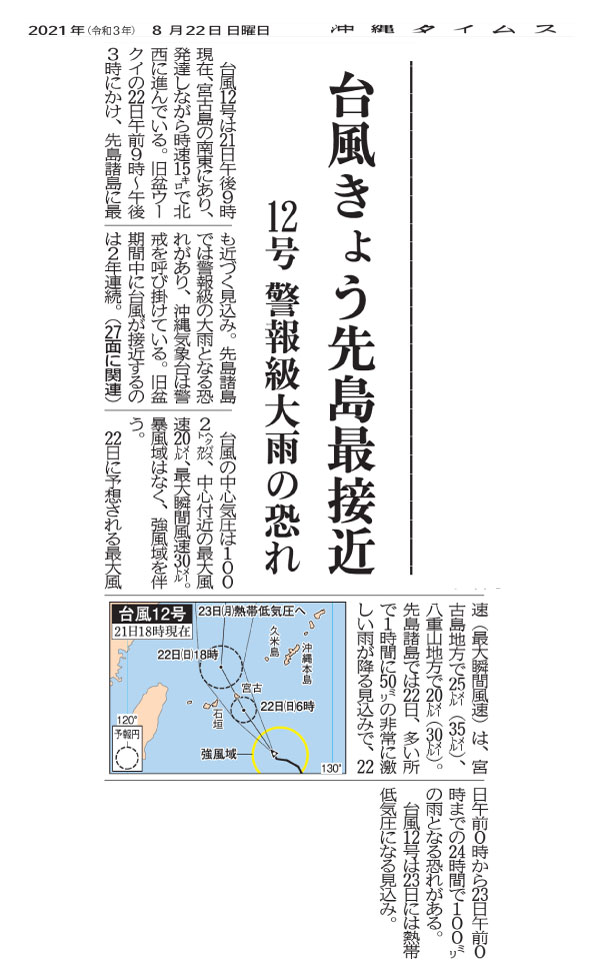
Typhoon No. 12 makes closest approach to Sakishima Island today
Fear of warning-level heavy rain
August 22, 2021
As of 9 pm on the 21st Typhoon No. 12 is located in the southeast of Miyakojima, and is moving northwest at a speed of 15 km/h while picking up strength. It is expected to come closest to the Sakishima Islands between 9 am and 3 pm on August 22, the day of the Lunar Bon Festival Ukui. The Okinawa Meteorological Observatory has issued a warning for heavy rainfall in the Sakishima Islands. This is the second year in a row that a typhoon has approached the islands during the Obon Festival.
The typhoon’s central pressure is 1002 hectopascals, with a maximum wind speed of 20 meters near the center and a maximum instantaneous wind speed of 30 meters. There is no storm area, but there will be strong wind area.
The maximum wind speed (maximum instantaneous wind speed) expected on the 22nd will be 25 meters (35 meters) in the Miyakojima area and 20 meters (30 meters) in the Yaeyama area. A very heavy rainfall of 50 millimeters per hour is expected in many places in the Sakishima Islands on the 22nd, and there is a risk of 100 millimeters of rain in 24 hours from midnight of the 22nd to midnight of the 23rd.
Typhoon No.12 is expected to become a tropical depression on the 23rd.
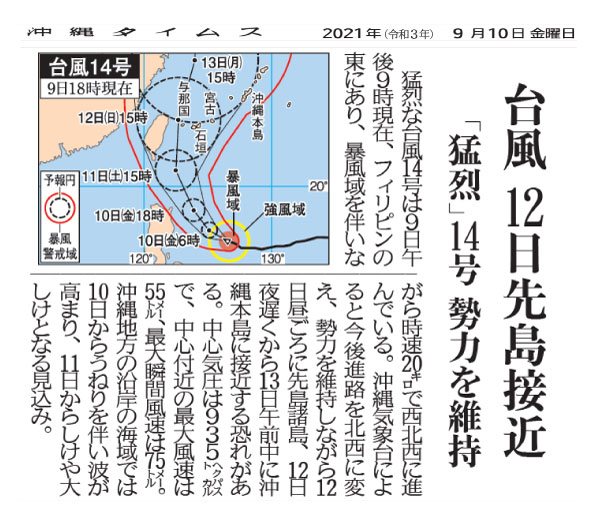
Typhoon No. 12 approaches Sakishima Islands
Fierce Typhoon No. 14 maintains its strength
September 10. 2021
As of 9 pm on the 9th Typhoon No. 14, a fierce typhoon, is east of the Philippines, and is moving west-northwest at 20 kilometers per hour with a storm zone. According to the Okinawa Meteorological Observatory, the typhoon will change its course to the northwest and may approach the Sakishima Islands around noon on the 12th and the main island of Okinawa late in the period from the evening of the 12th to the morning of the 13th, all the while maintaining its power. The central pressure is 935 hectopascals, the maximum wind speed near the center is 55 meters, and the maximum instantaneous wind speed is 75 meters. Waves with accompanying swells are expected to rise in the coastal waters off the Okinawa region from the 10th, and seas are predicted to be rough quite stormy from the 11th.
The maximum wind speed (maximum instantaneous wind speed) expected on the 22nd will be 25 meters (35 meters) in the Miyakojima area and 20 meters (30 meters) in the Yaeyama area.
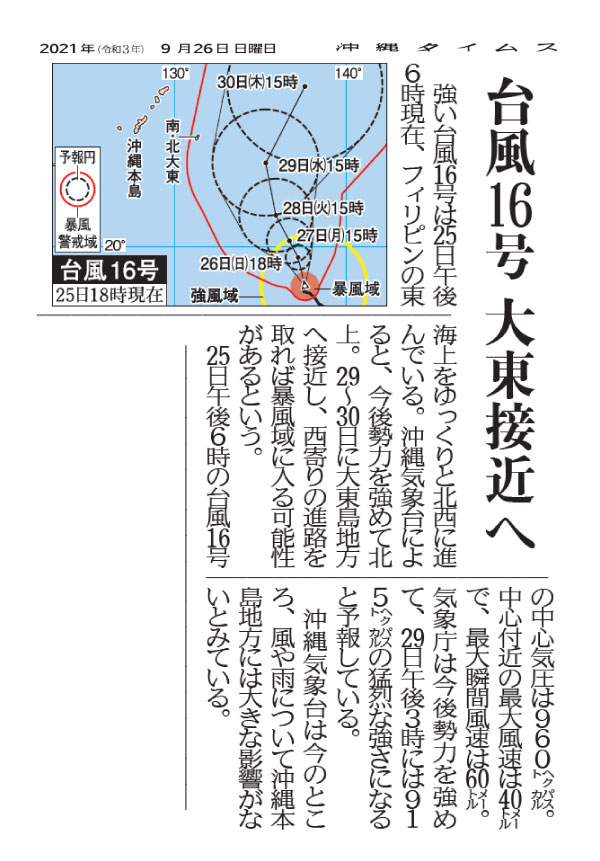
Typhoon No. 16 approaching Daito Islands
September 26, 2021
Typhoon No. 16, a strong typhoon, is slowly moving northwest over the sea east of the Philippines. According to the Okinawa Meteorological Observatory, it will strengthen and then move northward. On the 29th and 30th it will approach the Daito Islands area, and if it then takes a westward course, the possibility exists that it will enter the storm zone. The maximum wind speed near the center is 40 meters, and the maximum instantaneous wind speed is 60 meters.
The Japan Meteorological Agency predicts that the typhoon will strengthen and reach a fierce level of 915 hectopascals at 3 pm on the 29th.
The Okinawa Meteorological Observatory believes that at this time the wind and rain will have no significant impact on the main island of Okinawa.

Strong winds expected in Okinawa main island and Sakishima Islands
Typhoon No. 18 arrives today
October 10, 2021
According to the Okinawa Meteorological Observatory, as of 6 pm on October 9th Typhoon No. 18, an extremely large and strong typhoon, is mostly stationary sea east of the Philippines. The typhoon will continue to develop and is expected to make its closest approach between October 10th and 13th, engulfing the Okinawa main island region and the Sakishima Islands in a strong wind zone.
The typhoon is expected to have a central pressure of 992 hectopascals, maximum wind speed of 23 meters, and the maximum instantaneous wind speed is 35 meters. It is forecast to move north-northwest at 25 kilometers per hour on the 10th. It will not be accompanied by a storm zone. The maximum wind speed (maximum instantaneous wind speed) expected on the 10th is 15 meters (25 meters) in the main island of Okinawa¬¬, the Sakishima Islands, and the Daito Islands area.
The Okinawa main island area and the Sakishima Islands are expected to experience rough seas on the 10th and be very stormy from the 11th. Depending on the track of the typhoon, Sakishima Islands may experience warning-level heavy rains on the 12th.
According to the Okinawa Passenger Ship Association, ferry services between Naha City and Kagoshima Prefecture have been cancelled due to the typhoon. The status of ships connecting the main island of Okinawa, the Miyako Islands and Yaeyama Islands, will be determined early on the morning of the 10th.
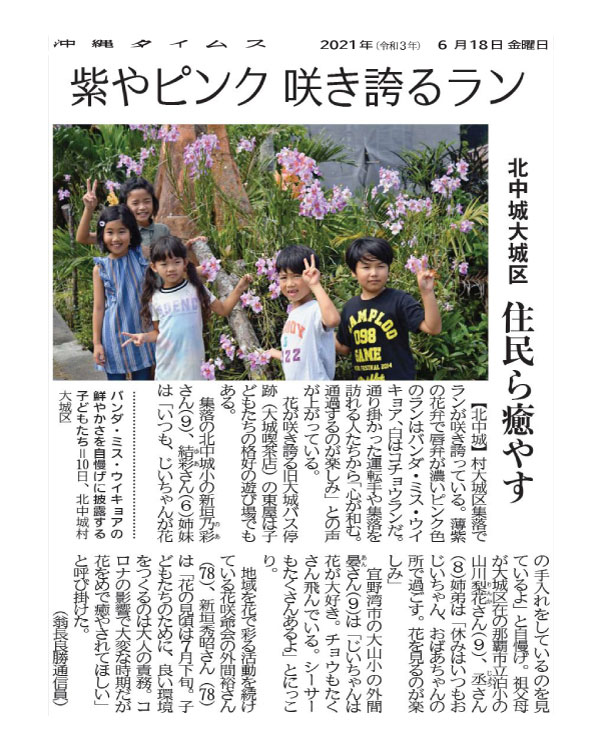
Purple and pink orchids in full bloom
A soothing sight for residents in Ogusuku, Kitanakagusuku Village
June 18, 2021
Orchids are in full bloom in Ogusuku, Kitanakagusuku Village. The orchids, with light purple petals and dark pink labial valves are Vanda Miss Joaquim, and the white is Phalaenopsis orchid. Drivers passing by and visitors to the village remark how soothing they find the sight, and how much they enjoy passing by this place.
The flowers are in full bloom at the pavilion at the site of the old Ogusuku bus stop. The sign there says Ogusuku Coffee Shop, but it’s not a coffee shop, but a rest area with a table and some chairs, and is also a favorite playground for children.
Sisters Noa Aragaki (9) and Yua (6), pupils at Kitanakagusuku Elementary School in the village, proudly said, “We always see our grandpa taking care of the flowers.” Rinka Yamakawa (9) and her brother, Jo (8) pupils of Tomari Elementary School students in Naha City, whose grandparents live in Ogusuku-ku, said, “We always spend our holidays at our grandma and grandpa’s place and forward to seeing the flowers.”
An Hokama (9), a pupil at Oyama Elementary School in Ginowan City, said, “Grandpa loves flowers. There are lots of butterflies flying around. He also has so many Shisa (Okinawan guardian lion statues) in his garden,” she said with a smile.
Mr. Hiroshi Hokama (78) and Mr. Hideaki Aragaki (78) of the Hanasaka Jijii Group, which has been working to beautify the community with flowers, said, “The best time to see the flowers is late July. It is our responsibility as adults to create a good environment for the children. We’re going through a difficult time now because of the COVID-19 pandemic, but we hope that people will enjoy the flowers and be refreshed and soothed by them.”
(Reported by Yoshikatsu Onaga)
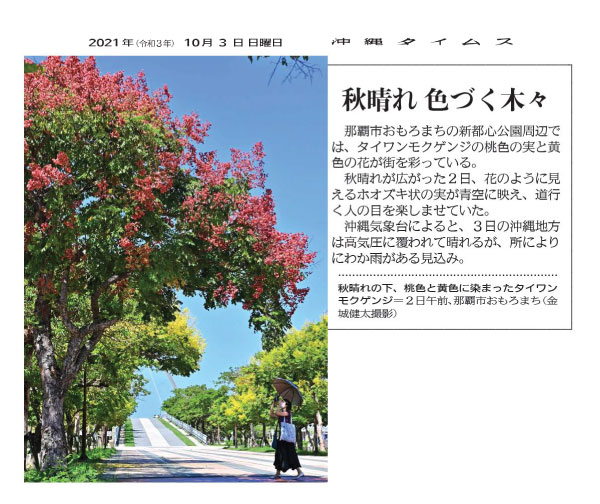
Clear autumn skies, trees changing color
October 3, 2021
In the vicinity of Shintoshin (New Urban Center) Park in Omoromachi, Naha City, the peach-colored fruits and yellow flowers of the flamegold rain tree are brightening up the city with their flower.
On the 2nd, when sunny autumn weather prevailed, the physalis-like fruits that looked like flowers sparkled in the blue sky, delighting the eyes of passersby.
According to the Okinawa Metrological Observatory, on the 3rd a high pressure system will cover the Okinawa region skies will be sunny, but it is expected that there will be some showers.
Flamegold rain tree dyed in pink and yellow under the clear autumn sky
on the morning of the 2nd, Omoromachi, Naha City (Photo by Kenta Kinjo)
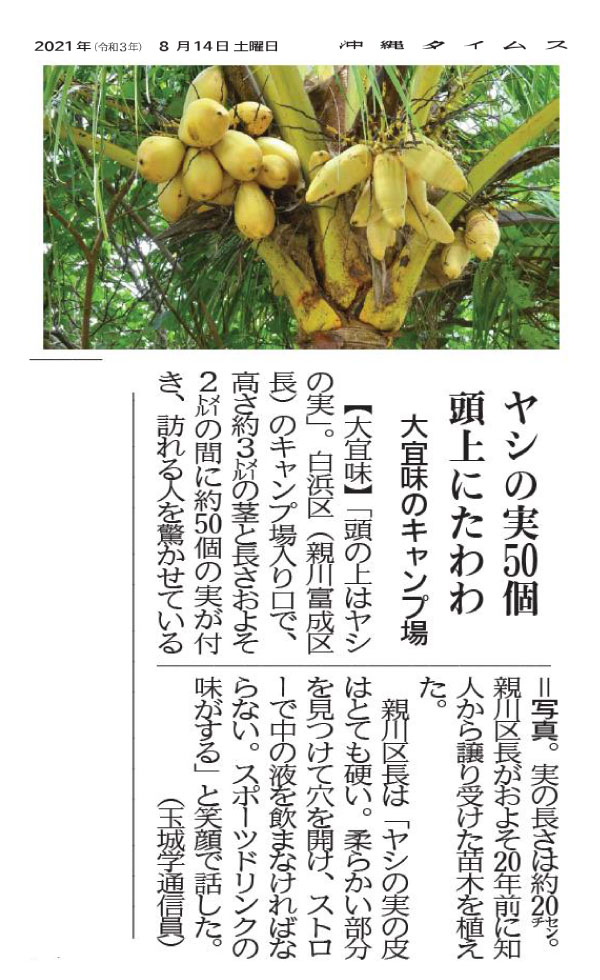
Fifty coconuts above our heads
Ogimi Campground
August 14, 2021
“There are coconuts drooping down over our heads.” At the entrance to a campground in Shirahama Ward (Mr. Tominari Oyakawa, Ward chief), about 50 coconuts are growing between a three-meter high stem and about two-meter long branches, surprising visitors. (See photo)
The coconuts are each about twenty centimeters long. Mr. Oyakawa planted the saplings, which he received from an acquaintance, about twenty years ago.
“The skin of the coconut is extremely hard, so the trick is to find a soft spot, make a hole there, and drink the liquid inside with a straw. It tastes a lot like a sports drink,” he said with a smile.
(Reported by Manabu Tamaki)
Photo: The coconuts are about 20 centimeters long. Mr. Oyakawa planted the saplings he received from an acquaintance about twenty years ago.
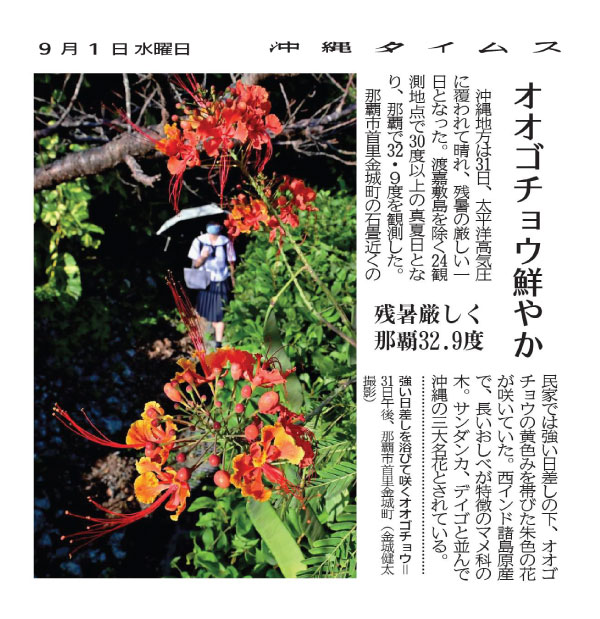
Bright Colors of the Peacock flower
Summer heat is still severe, 32.9 degrees Celsius in Naha City
September 1, 2021
On September 31, Okinawa was covered by a Pacific high-pressure system and the weather was clear, making it a hot and humid day. Expect for Tokajiki Island, twenty-four observation points recorded midsummer temperatures of 30 degrees or higher, with Naha recording 32.9 degrees.
At a house near the stone pavement in Shurikinjo-cho, Naha City, the yellowish vermilion flowers of the Peacock Flower were blooming under the strong sunlight.
Native to the West Indies, this legume tree is known for its long stamens, and is considered one of the three best known flowers in Okinawa, along with Sandanka and Diego.
Peacock flower blooming in strong sunlight
Shurikinjo-cho, Naha City on the afternoon of the 31st
(Photo by Kenta Kinjo)
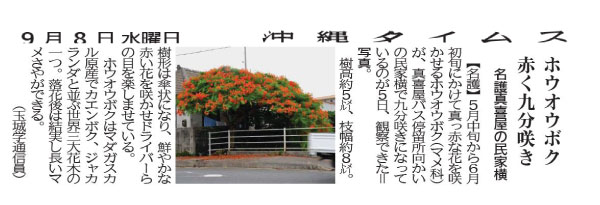
Red royal poinciana ninety percent blooming
Next to a private house in Makiya, Nago City
September 8, 2021
On the 5th, I was able to observe that ninety percent of the royal poinciana (Fabaceae), which blooms with bright red flowers from mid-May to early June, were blooming next to a private house across from the Makiya bus stop. (Photo)
The tree is about five meters tall and the branches are about eight meters wide. The tree is umbrella-shaped, and its bright red flowers please the eyes of people driving by.
Royal Poinciana is native to Madagascar and is one of the three largest flowering trees in the world, along with the Kaenboku (Flame of the Forest) and Jacaranda. After flowering, it bears fruit and produces long pods.
(Reported by Manabu Tamaki)
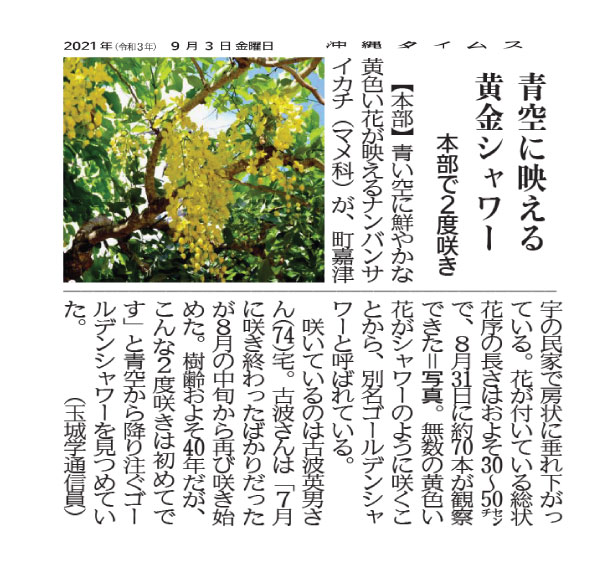
Golden shower in the Blue Sky
Blooming twice in Motobu Town
September 3, 2021
At a private home in Katsuu, Motobu Town the bright yellow flowers of the Nanbansaikachi (Fabaceae) are hanging in clusters and shining against the blue sky. The length of the racemous inflorescence with flowers is about thirty to fifty centimeters, and about seventy were observed on August 31st. (See photo) These are also called “Golden Shower” because of the countless yellow flowers that bloom like a shower.
The flowers were blooming at the home of Mr. Hideo Konami (74). He said, “They had just finished blooming in July, but started blooming again in mid-August. The tree is about forty years old, but this is the first time it has ever bloomed twice,” he said, gazing up the golden shower pouring down from the blue sky.
(Reported by Manabu Tamaki)
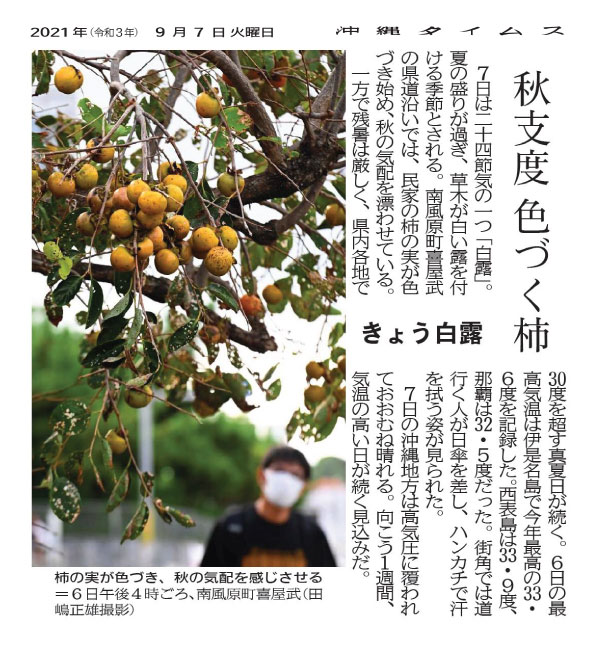
Preparing for autumn, persimmons turning color
White dew today
September 7, 2021
September 7th is “Bailu”, one of the 24 solar terms. It is the season when the height of summer has passed, and plants and trees are covered with white dew. Along the prefectural road in Kyan, Haebaru Town, persimmons in the garden of a private house are beginning to change color, bringing with them a sense of autumn’s approach. On the other hand, the lingering heat is still severe, with midsummer days exceeding 30 degrees Celsius throughout the prefecture. The highest temperature on the 6th was 33.6 degrees Celsius, the highest reached this year in Izena Island, 33.9 degrees in Iriomote Island, and 32.5 degrees in Naha City. On the streets, passersby were seen holding up shade parasols and wiping sweat off their faces with handkerchiefs.
On the 7th the Okinawa region will be covered by a high pressure system, bringing with it mostly sunny skies. It is expected that hot days will continue for the next week.
Persimmon fruits are changing color, a sign of autumn
Around 4pm on the 6th in Kyan, in Haebaru Town
(Photo by Masao Tajima)
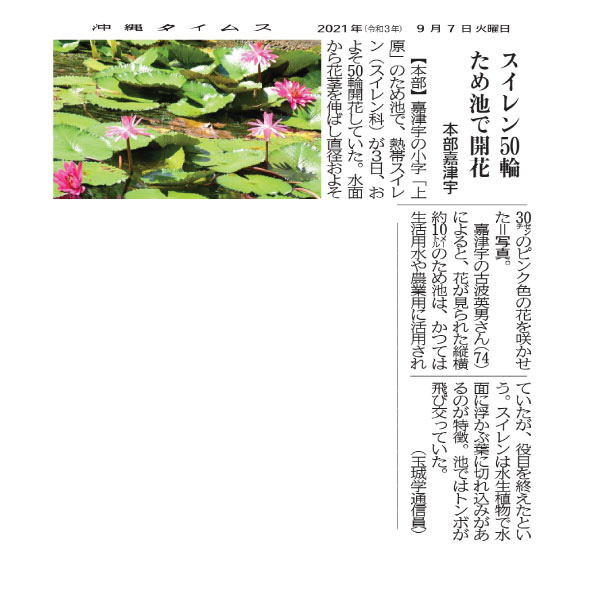
Fifty water lilies are blooming in a reservoir
Katsuu, Motobu Town
September 7, 2021
About fifty tropical water lilies (water lily family) were in bloom on the 3rd in the reservoir (pond) in Uehara, a subdivision of Katsu, Motobu Town. The stalks of the flowers grew up from the surface of the water, and pink flowers about 30 centimeters in diameter were blossoming. (Photo)
According to Mr. Hideo Konami (74), a resident of Katsuu, the reservoir, 10 meters long and wide, used to be used for domestic and agricultural purposes, but is no longer used in this role. The water lily is an aquatic plant and is characterized by its lobed leaves floating on the surface of the water. Dragonflies were also seen flying around in the pond. (Reported by Manabu Tamaki)
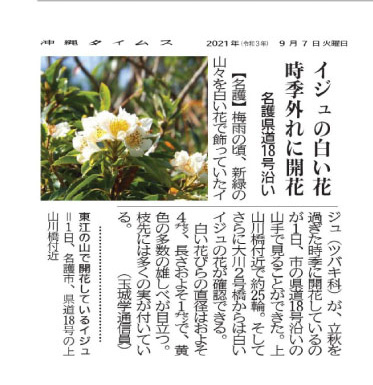
Iju white flower blossom out of season
Along Prefectural Road 18 in Nago City
September 7, 2021
On September 1st, Iju (Camellia sinensis), which used to adorn the fresh green mountains with white flowers during the rainy season, bloomed on the hillside along Prefectural Road 18 in Nago City, just after the start of autumn. About twenty-five flowers were blooming near the Kamiyamakawa Bridge. And white Iju flowers are visible, too, from the Okawa No.2 Bridge.
The white petals are about four centimeters in diameter and one centimeter long, with numerous prominent yellow stamens. There are many fruits on the tips of the branches.
(Reported by Manabu Tamaki)
Iju in bloom in the mountains of Agarie
Near the Kamiyamakawa Bridge on Prefectural Road 18 in Nago City on September 1st
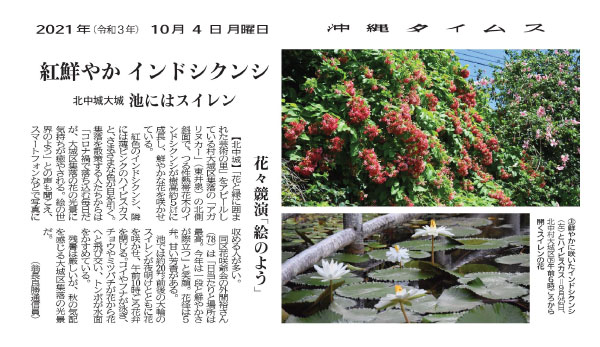
Bright red Quisqualis Indica
Water lilies in the pond at Ogusuku, Kitanakagusuku Village
Flowers vie with each other “Like a painting”
October 4, 2021
On the northern slope of “Agarinu Ka” in the village of Ogusuku, Kitanakagusuku Village, which is promoting itself as an “Art Village Surrounded by Flowers and Greenery,” the tropical vine Quisqualis Indica has grown to a height of about five meters and is full of bright, blooming flowers. The crimson Quisqualis Indica and the light pink Hibiscus next to it are eye-catching in their various colors.
People strolling through the village comment that the depression they feel because of the Covid-19 pandemic is healed through the sight of the flowers in Ogusuku village. “It’s like the world of a painting,” some commented. Many people took pictures of the flowers with their cell phones.
Mr. Hiroshi Hokama (78), a member of the Hanasaka Jijii Group, said, with a smile, “The sunshine and location are perfect. This year, the color of the flowers is even more beautiful.” The flowers have a sweet fragrance.
In the pond, large water lilies, about 20 centimeters in diameters, bloom at dawn and close their petals around 10 am. Carps and crucian carps can be seen swimming, butterflies and bees are flying from flower to flower, and dragonflies are hovering over the surface of the water.
Although the lingering summer heat is still intense, here in the village of Ogusuku this scene gives a sign of autumn. (Reported by Yoshikatsu Onaga)
Photo Caption:
Top: Vividly blooming Quisqualis Indica (left) and Hibiscus, September 25, in Ogusuku-ku, Kitanakagusuku Village
Bottom: Water Lily flowers open around 6 am
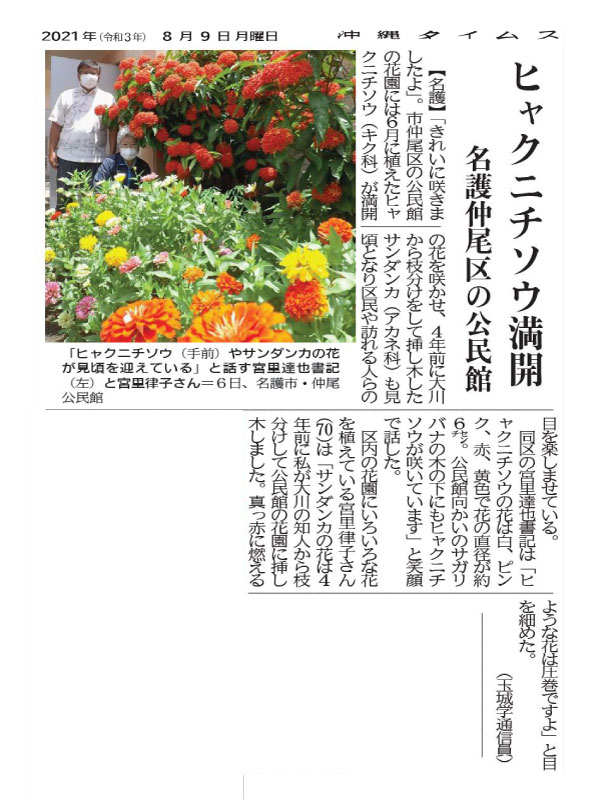
Zinnia in full bloom
Community center in Nakao-ku, Nago City
August 9, 2021
“It’s blooming beautifully.” In the flower garden of the community center in Nakao-ku, Nago City, the zinnia (Asteraceae) that were planted in June are in full bloom, and the Chinese Ixora (Rubiaceae) that were planted four years ago from a cutting from Okawa-ku are also in full bloom, delighting the eyes of residents and visitors.
Mr. Tatsuya Miyazato, secretary of Nakao-ku, said, “The zinnia flowers are white, pink, red and yellow, and the diameter of the flowers is about six centimeters. Zinnia flowers are also in bloom under the Barringtonia racemose tree across from the community center,” he said with a smile.
Mrs. Ritsuko Miyazato (70), who is planting various flowers in her flower garden in the Nakao-ku, said, happily, “The flowers of Chinese Ixora were from cuttings I got from an acquaintance in Okawa four years ago and planted these in the flower garden at the community center. The bright red flowers are simply stunning.”
(Reported by Manabu Tamaki)
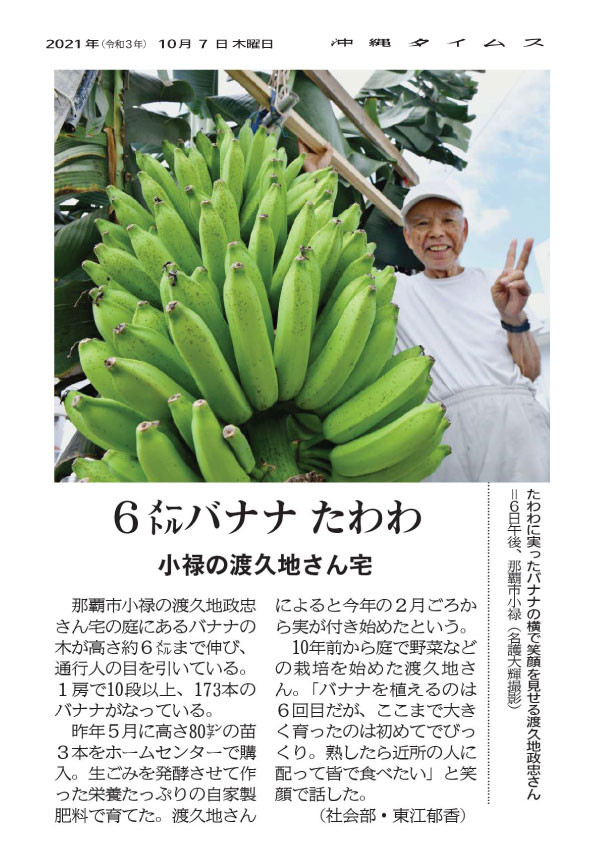
Six-meter tall banana tree with an incredible bunch of bananas
Mr. Masatada Toguchi’s house in Oroku
October 7, 2021
A banana tree in the garden of Mr. Masatada Toguchi’s house in Oroku, Naha City, has grown to a height of about six meters and is catching the eyes of passersby. There are 173 bananas in more than 10 tiers in one bunch.
In May last year, he bought three 80-centimeter tall seedlings at a home improvement store. They were grown using nutritious homemade fertilizer made by fermenting kitchen waste. According to Mr. Toguchi, the banana tree started to bear fruit around February of this year.
Mr. Toguchi started growing vegetables and other plants in his garden ten years ago. “This is the sixth time I’ve planted bananas, but this is the first time they have grown this big,” he said with a smile. “When they’re ripe, I want to give them to my neighbors so all of us can enjoy eating them.”
(Ayaka Agarie, Social Affairs Division)
Mr. Masatada Toguchi, smiles next to his bountiful harvest of bananas. Taken on the afternoon of the 6th, at Oroku, Naha City. (Photo by Daiki Nago)
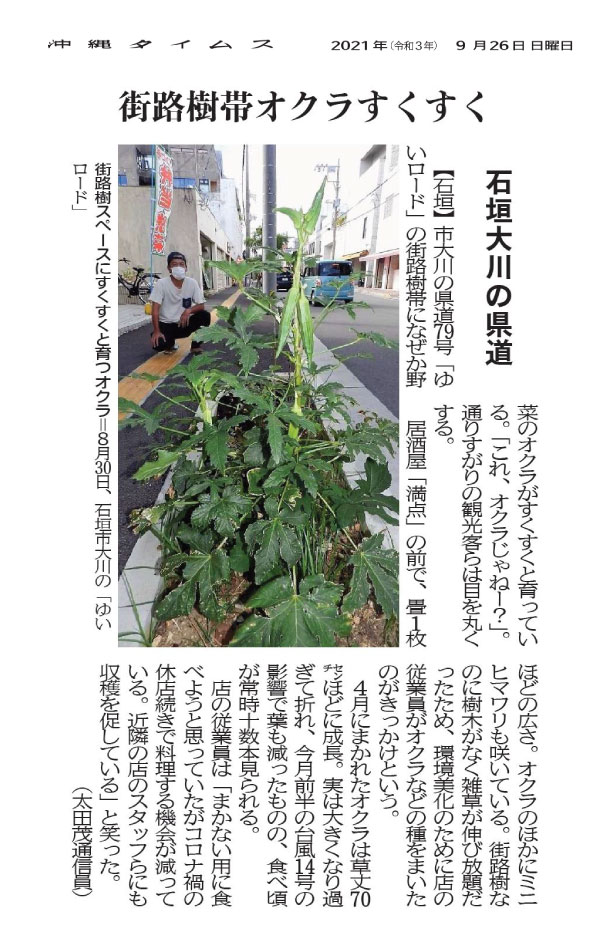
Okra is growing quickly in a street tree zone
Prefectural road in Okawa, Ishigaki City
September 26, 2021
For some reason, okra, a vegetable, is growing very well in the street tree zone on Prefectural Road No.79, “Yui Road,” in Okawa, Ishigaki City. Passing tourists ask, in surprise, “Isn’t this okra?”
The area is about the size of one tatami mat in front of the Izakaya (Japanese style pub) “Manten”.
Beside okra, mini sunflowers are also in bloom. There were no trees on the street tree zone and lots of weeds, so employees of the pub sowed seeds of okra and other plants to beautify the local environment.
The okra sown in April has grown to a height of about 70 centimeters. Actually, it became too big and broke, and although the number of leaves decreased due to Typhoon No. 14 in the first half of this month, there are always more than a dozen okra ready to eat.
An employee of the restaurant said, “We were thinking of cooking them for our employees’ meal, but we have had fewer opportunities to cook because of our place closing due to the Covid-19 pandemic. We are encouraging the staff of neighboring stores to harvest them as well.” (Reported by Shigeru Ota)
Photo caption:
Okra is growing quickly in the street tree space on “Yui Road” in Okawa, Ishigaki City on August 30th.
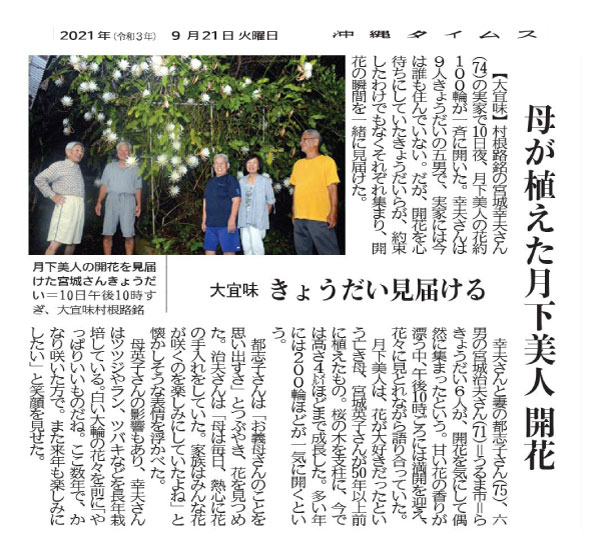
Queen of the Night by our mother now blossoming
Siblings appreciating it in Ogimi Village
September 21, 2021
On the night of September 10th, about 100 Queen of the Night flowers blossomed all at once at the parents’ house of Mr. Yukio Miyagi (74) in Nerome, Ogimi Village. Yukio is the fifth son of nine children, and their parents’ house now is unoccupied. However, the siblings who were looking forward to seeing the flowers spontaneously gathered to enjoy the moment they blossomed.
Yukio, his wife, Toshiko (75), the sixth son of the family, Haruo Miyagi (71), who lives in Uruma City, and three other siblings gathered there by chance, eager to see the flowers blossom. The sweet scent of the flowers wafted in the air, and they were in full bloom around 10 pm. The family enjoyed talking with each other while admiring the flowers.
The Queen of the Night was planted more than fifty years ago by their late mother, Eiko Miyagi, who loved flowers. Using a cherry tree as a support, it has now grown to a height of about four meters. In good years about 200 flowers open at once. “It reminds me of my late mother-in-law” Toshiko said as she gazed at the flowers. With a look of nostalgia on his face Haruo added, “Our mother was taking good care of the flowers every day. Everyone in the family was looking forward to seeing the flowers bloom.”
Influenced by his mother Eiko, Yukio has been growing azaleas, orchids and camellias for many years. Standing in front of the large white flowers, he said, with a smile, “How wonderful it is to see these flowers! They have bloomed quite a lot in the past few years, and I look forward to seeing them again next year.”
Photo:
Brothers and sisters of the Miyagi family witnessed the blooming of the Queen of the Night
10 pm on the 10th in Nerome, Ogimi Village
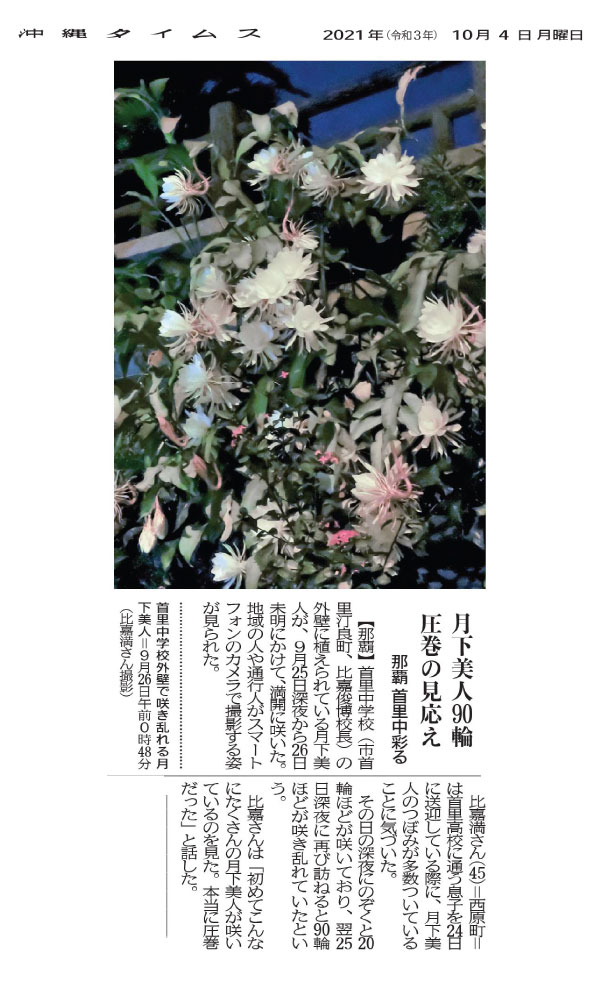
Ninety flowers of the Queen of the Night, a Stunning Sight
Decorating the Shuri Junior High School in Naha City
October 4, 2021
The Queen of the Night planted on the outside wall of Shuri Junior High School (in Shuritera Town, Naha City, Toshihiro Higa, Principal) was in full bloom from midnight on September 25th to early on the morning of September 26th. Many residents and passersby took photos with their cell phones.
Mr. Mitsuru Higa (45), a resident of Nishihara Town, was taking his son to and from Shuri Junior High School on the 24th when he noticed the many buds on the Queen of the Night. When he peeked at the buds late that night, he found about 20 flowers in bloom, and when he visited again late the next day, about 90 flowers were blossoming. “It was the first time I ever saw so many Queen of the Night in bloom,” Mr. Higa said. “It was simply amazing.”
Photo:
The Queen of the Night in full bloom on the outer wall of Shuri Junior High School
12:48 am on September 26. (Photo by Mitsuru Higa)
Photo:
Brothers and sisters of the Miyagi family witnessed the blooming of the Queen of the Night
10 pm on the 10th in Nerome, Ogimi Village
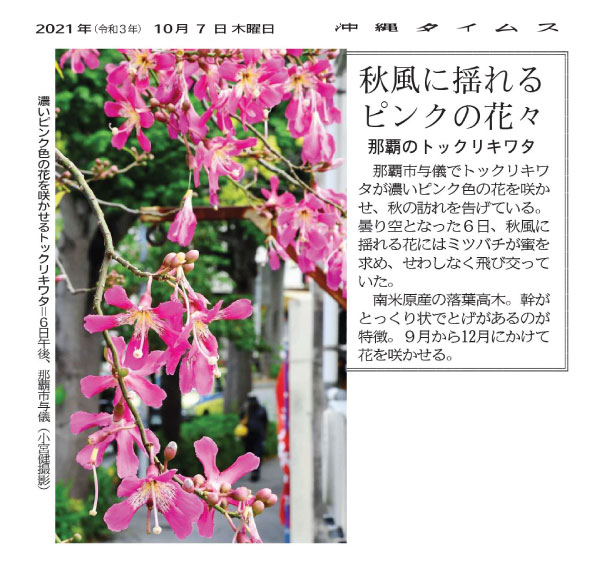
Pink flowers swaying in the autumn breeze
Silk floss trees in Naha
October 7, 2021
In Yogi, Naha City, the deep pink flowers of the silk floss tree plant announce the arrival of autumn.
On October 6th, under cloudy skies, the flowers were swaying in the autumn breeze as bees buzz about in search of nectar.
The deciduous tree, which is native to South America, is known for its round trunk and thorns. The flowers bloom from September to December.
Photo:
Silk floss tree with dark pink flowers
On the afternoon of October 6th in Yogi, Naha City
(Photo by Ken Komiya)
(All articles are provided by Okinawa Times)
(October 22, 2021)
Editor’s Picks
-

#196 The Steadily Evolving EM Nature Farming Method at the Blue Sky Palace - Part 6 -

#195 The Steadily Evolving EM Nature Farming Method at the Blue Sky Palace - Part 5 -

#191 Steadily Evolving EM Nature Farming Method at the Blue Sky Palace -

#190 Quantum Mechanical Effects of EM Gravitron Charcoal
- 2025
- Sep:#209 The Widespread Use of EM in Ecuador
- Sep:#208 The Widespread Use of EM in Chile
- Jul:#207 Peru, where EM has taken root throughout the country
- May:#206 EM Application Technology in Paraguay Begins to Evolve into Advanced Circular Agriculture
- May:#205 Practical Application of Soil Disinfectant-Free Cultivation Using EM Technology
- Apr:#204 How EM Use Has Spread Throughout the Philippines
- Mar:#203 How to Use EM to Fundamentally Solve the Problem of Agricultural Residue Burning
- Feb:#202 The Spread of EM technology in Germany
- Jan:#201 The 2nd Ichiro Masaki Memorial Universal Village EM International Conference
- Jan:#200 Cleanup of the Ala Wai Canal in Hawaii, where social bonds are strengthened using EM
- 2024
- Nov:#199 EM trials in India with bananas, tomatoes, and pomegranates
- Oct:#198 The Steadily Evolving EM Nature Farming Method at the Blue Sky Palace - Part 8
- Sep:#197 The Steadily Evolving EM Nature Farming Method at the Blue Sky Palace - Part 7
- Aug:#196 The Steadily Evolving EM Nature Farming Method at the Blue Sky Palace - Part 6
- Jul:#195 The Steadily Evolving EM Nature Farming Method at the Blue Sky Palace - Part 5
- Jun:#194 Steadily Evolving EM Nature Farming Method at the Blue Sky Palace - Part 4
- May:#193 Steadily Evolving EM Nature Farming Method at the Blue Sky Palace - Part 3
- May:#192 Steadily Evolving EM Nature Farming Method at the Blue Sky Palace - Part 2
- Apr:#191 Steadily Evolving EM Nature Farming Method at the Blue Sky Palace
- Mar:#190 Quantum Mechanical Effects of EM Gravitron Charcoal
- Mar:#189 The barrier space in Okinawa (Ryukyu Islands) has risen to another dimension
- Jan:#188 Sixty Days after Typhoon No.6
- 2023
- Oct:#187 Supermassive Typhoon No.6 and Subsequent Typhoon No. 11
- Sep:#186 Massive Typhoon No.6 that swallowed the Ryukyu Islands Graviton barrier
- Sep:#185 August 8th is World “EM Mudball Day”
- Aug:#184 A disease-free life depends on the health of the intestinal microbiome.
- Jul:#183 Trial and Error at the Blue-Sky Palace, Part 3
- Jun:#182 Trial and Error at the Blue-Sky Palace, Part 2
- Apr:#181 Trial and Error at the Blue-Sky Palace
- Mar:#180 Ala Wai Canal Cleanup Project in Waikiki, Hawaii
- Feb:#179 High-Yield, High-Quality Rice Production Using EM
- Feb:#178 The Progress the "Soil Preparation Workshop" of the Oishi 3-chan Club (Part 2)
- Jan:#177 Organic Farming Instructional Manual Using EM
- 2022
- Nov:#176 The Typhoon Situation in Okinawa in 2022
- Sep:#175 Third-Party Verification of the Graviton barrier in Okinawa Part-2
- Sep:#174 Third-Party Verification of the Graviton barrier in Okinawa
- Aug:#173 Ecosystem Changes Observed in Okinawa in 2021 Part-5
- Jun:#172 Ecosystem Changes Observed in Okinawa in 2021 Part-4
- May:#171 Ecosystem Changes Observed in Okinawa in 2021 Part-3
- Apr:#170 Ecosystem Changes Observed in Okinawa in 2021 Part-2
- Mar:#169 Koizumi Farm in Kamakura Continues to Evolve
- Feb:#168 Ecosystem Changes Observed in Okinawa in 2021 Part-1
- 2021
- Dec:#167 Enjoying EM Technology While Enriching the Local Ecosystem
- Nov:#166 A Case Study of the Use of EM in a Next Generation Free School in Tune with the Cycles of Nature
- Oct:#165 Typhoon conditions and flowers in Okinawa from August to October
- Sep:#164 Re-learning the origins of river purification using EM Cleaning up the Dairyuji River in Senami (Murakami City, Niigata Prefecture)
- Aug:#163 Measures Against Natural Disasters and Re-learning the Starting Point of EM
- Jul:#162 Summary of FFC (Foods for Children) Okinawa Forum 2021
- Jun:#161 Restoring the Vigor of an Old Tree and Purifying the Environment with EM Technology That Even an Amateur Can Do
- May:#160 The Public is Beginning to Recognize the Use of EM Smokeless Carbonizers
- Apr:#159 EM Hado (EM Graviton) that exerts quantum superposition effect over time
- Mar:#158 Virus-free Okinawan Plants Through Use of an EM Graviton Barrier
- Jan:#157 Enjoyable Farming for Self-Sufficiency that Even Amateurs Can Do
- 2020
- Dec:#156 EM quantum energy effect occurring in Okinawa
- Nov:#155 Implementing EM graviton farming as a flood countermeasure for apple orchards
- Oct:#154 The Latest Book on the Practical Uses of EM "You Are the One Who Draws Out the Power of Microorganisms," by Chizuko Nomoto
- Sep:#153 Application of EM technology to long periods of rain, lack of sunshine, storms, heavy rains, etc.
- Aug:#152 EM application in Kitanakagusuku village plant waste recycling yard
- Jul:#151 Natural Disaster Countermeasures Using EM Technology: Part 2
- Jul:#150 Natural Disaster Countermeasures Using EM Technology
- May:#149 How to make your home and workplace an energy spot by living a complete EM lifestyle: creating the ultimate source of health and environmental purification
- Apr:#148 EM, Viruses and the Pandemic
- Apr:#147 New agriculture applying quantum mechanics Part 2
- Apr:#146 New agriculture applying quantum mechanics
- Apr:#145 Wonderful EM Miracle
- 2019
- Nov:#144 The movie “Revival II” and the reality of Fukushima
- Oct:#143 Boundary dome and foliar spraying of EM・X GOLD and EM 3
- Oct:#142 Kirakira (Sparkling) Summer Vegetable Festa in 2019
- Aug:#141 Excessive salt inevitably causes salt damage
- Jul:#140 Diverse applications of charcoal Part 3
- Jun:#139 Diverse applications of charcoal Part 2
- Jun:#138 Diverse applications of charcoal
- Jun:#137 Purification power of salt
- May:#136 The degree of soil contamination is a reflection of the microflora
- May:#135 Definitive use of EM barriers to deal with typhoons
- May:#134 Implementing authentic Nature Farming
- May:#133 How to enhance healthy Hado (wave energy) by EM
- May:#132 Eating Dirt (Soil)
- May:#131 Hado (Wave energy) involved in health
- May:#130 Reaffirming EM technology to realize the essence of agriculture
- May:#129 The 2nd EM Producer Networking Meeting
- Apr:#128 Understanding the application of seawater and salt in crop cultivation
- Apr:#127 Prevention of Disasters by EM Technology
- Mar:#126 Quantum overlay effective utilization of EM
- Jan:#125 EM Disaster Recovery Support Projects in 2017
- 2018
- 2017
- Aug:#121 Escape from conventional agricultural traps
- Jul:#120 Limitation and important caveats regarding utilization of salt
- Jun:#119 EM Technology to Break Through the Limits of Pesticide-Free Strawberries
- May:#118 Application of barriers using EM rectification force
- Apr:#117 The 1st EM Produce Growers' Networking Conference
- Mar:#116 Sumizo kun: The Ultimate Versatile Carbonization Equipment
- Feb:#115 How to make and use simple carbonized and rectified ash
- Jan:#114 Achievements of 2016
- 2016
- Dec:#113 Definitive Measures Against Typhoons
- Nov:#112 International Conference on Universal Village
- Oct:#111 90% of Your Body is Microbes
- Sep:#110 Disaster Countermeasures Using EM
- Aug:#109: Changes in the Natural Environment by EM Barrier Domes in Okinawa
- Jul:#108: Multi-purpose Utilization of Activated EM with Seawater and Salt
- Jun:#107: Marine Day, when EM Mudballs and Activated EM are Applied Throughout Japan
- May:#106: The Function of EM and Gravitational Waves–Part 3
- Apr:#105: The Function of EM and Gravitational Waves–Part 2
- Feb:#104: The Function of EM and Gravitational Waves
- Feb:#103: The Importance of Phototrophic Bacteria in EM
- 2015
- Dec:#102: Results of Environmental Forum "Utsukushima EM Paradise" 2015
- Nov:#101: Environmental Forum "Utsukushima EM Paradise" 2015
- Oct:#100: A New Phase of Limit Breakthrough Using EM
- Sep:#99: A New Phase of Limit Breakthrough through EM
- Aug:#98: The Tokyo Bay Area Began Creating a Truly Livable Hometown
- Jul:#97: Rectifying Effects of EM
- Jun:#96: Lake Suwa Sousei lecture
- May:#95: In Order to Further Ensure Limit Breakthrough
- Apr:#94: Theatrical Release of the Documentary Film SOSEI-Revival to Enlighten People on the New Possibilities of Microorganisms
- Mar:#93: What Underlies Limit Breakthrough (Part 2)
- Feb:#92: EM Functions to Break Through Limits
- Jan:#91: At the Start of 2015
- 2014
- Dec:#90: Looking Back at 2014
- Nov:#89: Shikoku EM FESTA 2014, Virtuous Circle Conference in Matsuyama, Ehime Prefecture
- Oct:#88: Using EM to Deal with Weather Disasters (Part 2)
- Sep:#87: Current Status of Radioactivity Measures Using EM in Fukushima
- Aug:#86: APNAN (Asia Pacific Natural Agriculture Network) 25th Anniversary Conference in 2014
- Jul:#85: Using EM to Deal with Weather Disasters
- Jun:#84: Substantial Improvement of Soil
- May:#83: The Energy Rectification Force of EM
- Apr:#82: The Annual 18th EM Technology Exchange Meeting and Tohoku Conference in Shichigahama
- Mar:#81: Salmon going upstream in Kitaura (Kasumigaura)
- Feb:#80: The Microbiome Again
- Jan:#79: Inauguration of the Federation of Diet Members Who Use and Apply Effective Microorganisms
- 2013
- Dec:#78: Receiving an Honorary Doctoral Degree from Rajamangala University of Technology in Thailand
- Nov:#77: The Use of EM in School Education in Bhutan
- Oct:#76: Well of Bonding
- Sep:#75: The Background to EM Not Being Employed by Public Institutions to Deal with Radiation
- Aug:#74: Dealing with Disaster: Using EM in Crisis Management
- Jul:#73: EM Events on Ocean Day
- Jun:#72: Using EM to Deal With Heat Stroke and Summer Heat Fatigue
- May:#71: An EM Model Town in Malaysia
- Apr:#70: Steps the Japanese Government is Taking to Deal with Radiation: Are They Really Safe?
- Mar:#69: EM Group Disaster Reconstruction Aid Project in Fukushima
- Feb:#68: EM and Microbiomes (Microbial Flora)
- Jan:#67: A Necessary Evil is Still Evil
- 2012
- Dec:#66: The 17th National EM Technology Exchange Conference / Hokkaido Conference in Sapporo
- Nov:#65: EM Forum 2012 in Okinawa and the Environmental Forum in Fukushima
- Oct:#64: 2012 EM Forum
- Sep:#63: A New Earth Saving Revolution
- Aug:#62: The Asahi Newspaper’s Misguided Reports About EM
- Jul:#61: Using EM in Radioactive Contamination Measures in Fukushima Prefecture
- Jun:#60: The Effects of Using EM to Inhibit the Absorption of Radioactivity as Confirmed in Fukushima
- May:#59: Recovery Support for the Great East Japan Earthquake
- Apr:#58: The Royal Kingdom of Thailand, in which EM Functions as a Set Government Policy
- Mar:#57: Report on the Measures Taken by Kingdom of Thailand Using EM to Deal with Polluted Water
- Feb:#56 EM™ as Part of National Policy in Thailand to Deal with Sanitation Issues Resulting from the Flood of 2011
- Jan:#55 The Law of Syntropy (Revitalization)
- 2011
- Dec:#54 EM Forum 2011
- Nov:#53 Shikoku EM Festa 2011- Zenjunkan no Wa (Virtuous Circle) Tokushima Conference in Naruto -
- Oct:#52 The Mystery of Interim Safety Values for Radioactive Material
- Sep:#51 Successful Radiation Countermeasures Using EM
- Aug:#50 Events on Sea Day in which EM Mud Balls are Thrown into the Water and Activated EM is Applied.
- May:#47 Dealing with the Damage Caused by the Eastern Japan Earthquake
- Apr:#46 Eastern Japan Earthquake
- Mar:#45 The 16th National EM Technology Hokuriku Conference in Fukui
- Feb:#44 More Thoughts on Avian Influenza and Foot-and-Mouth Disease
- Jan:#43 Happy New Year!
- 2010
- Dec:#42 Shikoku EM FESTA 2010・Zenjunkan no wa (Virtuous Circle) Fellowship Conference in Tobe, Ehime Prefecture
- Nov:#41 EM Forum 2010
- Oct:#40: My Thanks to the EM™ Volunteers Who Helped in the Fight Against Foot-and-Mouth Disease in Miyazaki Prefecture
- Sep:#39 International EM Mud Ball Day
- Jul:#37 Poland EM Forum 2010
- Jun:#36 EM Countermeasures Against Foot-and-Mouth Disease
- May:#35 Abnormal Weather
- Apr:#34 EM Activities in Thailand: Finding Solutions to the Challenges Facing the Nation
- Mar:#33 New Developments in the Evolution of EMTM in Thailand
- Feb:#32 Results Starting to Be Seen at the Mikasa Project
- Jan:#31 Towards an EM-Use Society
- 2009
- Dec:#30 EM Summit
- Nov:#29 The System in Penang State in Malaysia that Made the World EMTM Mudball Day a Success
- Oct:#28 The "World EM Mudball Day" in Malaysia
- Sep:#27 Validating EMTM Medicine: Case Study Reports from EM Users 2009. (Part 3)
- Sep:#26 Validating EMTM Medicine: Case Study Reports from EMTM Users 2009. (Part 2)
- Jul:#25 Validating EMTM Medicine: Case Study Reports from EMTM Users 2009. (Part 1)
- Jun:#24 Activities to Disseminate EM-Focused Nature Farming in China
- May:#23 Use of EMTM in Response to Swine Flu
- Apr:#22 Using EM to Solve Public Administrative Costs
- Mar:#21 Reaffirming the Versatility of EM
- Jan:#20 The Beginning of a New Era
- 2008
